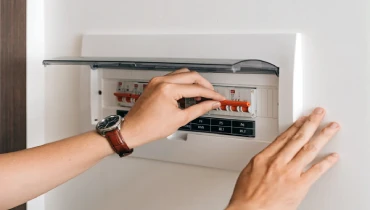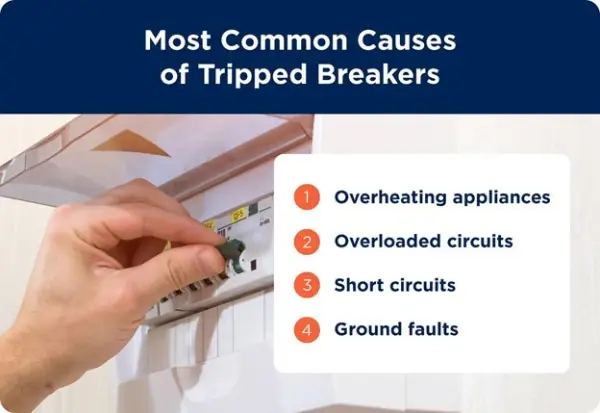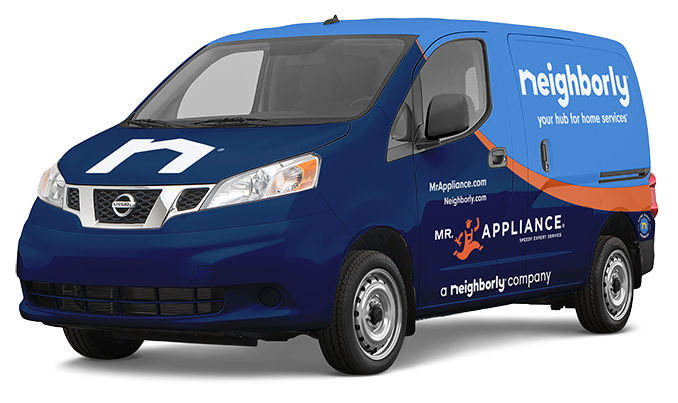
Mr. Appliance explains why appliances may trip circuit breakers and how to address the issue.
|
- An overloaded circuit
- An overheating appliance
- A short circuit
- A ground fault
Ignoring a consistently tripping circuit breaker can lead to electrical damage or even fire, so consult a professional for assistance.
A faulty circuit breaker isn’t just annoying — it could signify a bigger problem. If your breaker keeps tripping, it’s typically an overloaded circuit, overheated appliance, electrical short, or ground fault issue. Each problem has several potential causes, so troubleshooting the specific issue can quickly become complex and frustrating.
If this happens in your home, contact a service professional to address it immediately. Ignoring the issue could result in major electrical damage, electrical shock, or even a fire. Following some appliance safety tips and a few simple steps can help protect major appliances and allow you to determine the source of the problem.
1. Overheating Appliance
When an appliance overheats, it may trip the breaker. This is especially common with units that draw a lot of electricity, which includes:
- Washers and dryers
- Microwaves
- Air conditioners
- Dishwashers
- Refrigerators
- Ovens
Think about the major appliances on the circuit you’re having trouble with. Have you used one of your appliances more frequently lately? Does the appliance get very hot when in use? Double-check the manufacturer’s recommendations to ensure you’re not misusing the appliance or neglecting essential maintenance.
However, if you’ve been using your overheating appliances correctly, it could be a sign of a different issue. For example, a dryer might overheat and trip the breaker if a vent is blocked, a component has worn out, or there’s an electrical short somewhere.
How To Fix It
To run your high-power appliances safely and prevent tripped breakers:
- Keep your appliances clean: Regularly clean dirt, dust, and grease that accumulate on all your major appliances. Pay special attention to the coils, vents, filters, and cables.
- Be careful with extension cords: Avoid overloading extension cords beyond their capacity. Always use an extension cord with safety testing, and never plug an extension cord into another extension cord.
- Inspect outlets: Keep an eye out for signs of overloaded outlets, such as soot or sparks, when plugging in electronics. Ensure electrical connections and cords are secure and undamaged. Unplug appliances when not in use to prevent them from generating heat.
- Check the condenser: Keep an eye on appliances with condensers, like refrigerators, freezers, and some types of dryers. Clogged condensers can overheat, especially during the summer months.
- Practice preventative maintenance: Remove lint from the dryer after each load to prevent overheating and potential fire hazards. Clean appliances and their vents frequently to prevent overheating.
2. Overloaded Circuit
When a circuit tries to draw more power than it’s designed for, the circuit wires heat up, and the circuit breaker trips. This cuts off the flow of electricity to prevent further problems and potential damage to the circuit, electronics, or home. If you’re experiencing any of the following warning signs, it’s likely the result of an overloaded circuit breaker:
- Flickering or dimming lights
- Buzzing or humming sounds
- Burning smells
- Warm-to-the-touch wires
- Overheated appliances or electronics
How To Fix It
Get to the bottom of your overloaded circuit is overloaded:
- Identify the overloaded circuit: In addition to signs like flickering or dimming lights, buzzing and humming sounds, warm-to-the-touch wires, and other signs discussed, check the breaker box for a flipped breaker switch.
- Switch the tripped breaker on: Switch the tripped breaker to the “off” position and then back to “on.”
- Plug your appliances back in: Plug your appliances and electronics back in, one at a time. Stop this process immediately if you see any damage to wall outlets or external wires.
- Shift devices to another circuit: Shift some devices from the overloaded circuit to another general-purpose circuit to redistribute the load and prevent overheating.
- Use appliances sequentially: Use only one high-wattage appliance at a time. For example, if the microwave keeps tripping the breaker, wait until you’re finished with other appliances before using it.
- Install dedicated circuits: Consider hiring a professional to install dedicated circuits for high-power appliances.
3. Short Circuit
A short circuit is when there’s a low-resistance connection between two points in an electrical circuit. When this happens, the electrical current follows an unintended pathway and creates excessive current flow. This can occur in an outlet, a switch, or inside an appliance when the following happens:
- A hot wire comes into contact with another hot wire, a neutral wire, or the ground.
- Wires are damaged or severed (e.g., from rodent damage).
- Components in an appliance or electrical system are damaged or loose.
Short circuits create a surge of electricity that, at a minimum, can cause a breaker to trip. They can also lead to overheating, electrical fires, and damage to electronic devices, systems, and appliances. They pose significant property and personal safety risks. Identify and promptly address short circuits with the help of a service professional to prevent these potential hazards.
How To Fix It
Never try to fix a short circuit yourself, as it can be very dangerous. You can reset the breaker or investigate if a specific appliance is the issue yourself, but always hire a professional before you go any further.
- Reset the breaker: Unplug all appliances and turn off switches on the circuit. Reset the breaker and observe if the short occurs immediately, which indicates a problem with the entire circuit or electrical system. If not, the issue is likely within a specific circuit.
- Isolate the culprit: If the short is isolated to a specific circuit, systematically flip light switches to identify the source of the short circuit. If the breaker doesn’t trip, the problem may be with a specific appliance. Plug in the appliances one by one to identify the cause of the short.
- Call a professional: Fixing a short circuit can be complex and potentially dangerous — do not attempt to DIY a short circuit repair. When a service professional diagnoses an electrical short problem, they don’t just look for visible damage to wires and parts. They also test the outlet to determine whether the short circuit occurs within the appliance or at the outlet or switch to resolve the true root of the problem.
4. Ground Fault
A ground fault is a specific type of short circuit that occurs when a hot wire (current flowing through it) touches a grounded part of a switch box, appliance, or bare ground wire. This event causes the breaker and GFCI (ground fault circuit interrupter) outlets to trip. Ground faults may occur due to:
- Water leaks
- Wire damage
- Appliance damage
How To Fix It
Do not attempt to repair a ground fault yourself. Ground faults can be a dangerous indicator that water and electricity are making contact. Don’t risk electrocution, injury, or worse. Leave all the troubleshooting and repair work to a trusted service professional like Mr. Appliance.
Notice Any Other Appliance Problems?
A breaker that keeps tripping is an inconvenience at best. But if left unchecked, it can cause injuries or extensive damage to your appliances, property, and home.
If you're struggling to keep your appliances running without tripping the breaker, you can count on your local Mr. Appliance for prompt, expert repair service and upfront, flat-rate prices. Schedule an appointment or call us today.
FAQs About Troubleshooting Circuit Breakers
Decades of experience, highly skilled service professionals, and a commitment to exceptional customer service have made Mr. Appliance a trusted leader in appliance maintenance and repairs. Our commitment to keeping your appliances up and running includes using our many years of experience and expertise to answer your questions. Here are answers to some of the most frequently asked questions about circuit breaker repair.
How do I find out what's tripping my circuit breaker?
High-powered kitchen appliances like refrigerators, microwaves, and toasters are common culprits of tripped breakers, especially when used simultaneously. Bathroom appliances like hair dryers and curling irons also frequently cause trips when they draw sudden bursts of power.
To determine what's tripping your breaker, follow these diagnostic steps:
- Turn off and unplug all electronics and appliances in the affected area.
- Reset the breaker by firmly pushing it to the “OFF” position first, then to the “ON” position.
- Systematically reconnect devices one at a time, waiting 2–3 minutes between each connection.
- When the breaker trips again, you will have identified the problematic appliance or circuit.
This process helps pinpoint whether the issue stems from a specific appliance or from the circuit itself. If you find that multiple essential appliances are causing trips when used together, a service professional can evaluate whether dedicated circuits would help accommodate your household's electrical demands safely.
Can a circuit breaker go bad if it keeps tripping?
Yes, a breaker can go bad if it keeps tripping. Circuit breakers are mechanical devices designed to protect electrical circuits from damage by automatically shutting off power when they detect excessive current flow. However, they're not meant to trip constantly.
Repeated tripping causes wear and tear on the internal components of the breaker, including the spring mechanisms and contact points. Over time, this wear can lead to:
- Inconsistent performance. The breaker may trip at currents below its rating.
- Failure to trip when needed, creating a dangerous fire hazard
- Physical damage to the breaker switch itself, making it difficult to reset
- Deterioration of the breaker's connection to the electrical panel
Frequent tripping can significantly reduce the lifespan of your circuit breaker, but circuit breaker repair is not a DIY issue. If your breaker continues to trip even after you've addressed potential overload issues, schedule a professional inspection and potential breaker replacement.
How can you tell if a breaker is bad?
If a breaker continues to trip without an apparent cause, it may indicate the breaker itself is faulty. Conduct a visual inspection for these telltale signs:
- Discoloration or scorch marks on the breaker or the surrounding panel area
- Burning smells coming from the electrical panel
- Buzzing or crackling noises when the breaker is on
- A breaker that feels warm or hot to the touch (using the back of your hand)
- Physical damage to the breaker switch
- A loose connection in the panel
You can also test the breaker's functionality by manually switching it off and then on again. A breaker that feels loose, won't stay in position, or doesn't produce a clear “snap” sound when reset may be worn out. If your inspection reveals any abnormalities or if electrical problems persist despite troubleshooting, consult a qualified service professional.
Why does my circuit breaker keep tripping?
Breakers typically trip due to one of four main causes:
- Circuit overload: This is the most common reason, occurring when the electrical demand exceeds what the circuit can safely handle—in other words, when too many power-hungry appliances operate at the same time on the same circuit. Modern kitchens with multiple appliances are particularly susceptible to this issue.
- Short circuit: A more serious condition where an unintended connection forms between hot wires or between a hot wire and a neutral wire. Short circuits cause a significant current spike and pose a serious fire hazard. Signs include burning smells, visible sparks, or damaged outlets.
- Ground fault: Similar to a short circuit, but involves current flowing through an unintended path to ground. Ground faults commonly occur in areas with water exposure, such as kitchens and bathrooms.
- Faulty appliance: An appliance with damaged internal wiring or a failing component can draw excessive current or create intermittent short circuits.
Each of these causes requires a different solution, from simple redistribution of appliances across circuits to more complex electrical repairs. Understanding the root cause is essential for implementing a safe and effective solution.
How do you fix a circuit breaker that keeps tripping?
To fix a breaker that keeps tripping, first identify the specific cause:
For circuit overloads:
- Redistribute high-power appliances across different circuits.
- Limit simultaneous use of multiple appliances on the same circuit.
- Unplug devices that aren't in use to reduce constant load.
- Consider installing dedicated circuits for major appliances.
For short circuits or ground faults:
- Look for damaged outlets, switches, or visible wiring issues.
- Check for water exposure near electrical components.
- Inspect appliance cords for damage or wear.
- Stop using any outlet or device that shows signs of damage.
For faulty appliances:
- Test suspect appliances on different circuits to confirm the problem.
- Have older appliances professionally serviced or consider replacement.
- Pay attention to abnormal occurrences like unusual noises, smells, or heat.
When these basic steps don't resolve the issue, contact a qualified professional. Remember that electrical systems should never be left in a state where breakers trip repeatedly, as this indicates an unresolved safety issue that could lead to fire hazards or equipment damage.
Is it dangerous if a circuit breaker keeps tripping?
Yes, a circuit breaker that keeps tripping can be dangerous. While the breaker itself is doing its job by preventing overcurrent situations, repeated tripping indicates an unresolved electrical problem that demands attention.
Persistent breaker trips present several serious risks:
- Fire hazards: Overtaxed circuits generate excessive heat in wiring, which can deteriorate insulation and potentially ignite surrounding materials.
- Damage to appliances: Power fluctuations from frequent trips can damage sensitive electronic components in your appliances.
- Electrical shock risks: Underlying issues like ground faults can create shock hazards, especially in wet areas.
- Breaker failure: Constant tripping can eventually wear out the breaker mechanism, potentially allowing dangerous overloads to go unchecked.
Circuit breakers are safety devices designed to prevent these very dangers, but they're meant as a last line of defense, not a regular operating feature. When a breaker trips repeatedly, it's signaling that your electrical system is routinely operating outside safe parameters.
Which appliances are most likely to trip circuit breakers?
Certain household appliances are particularly notorious for tripping circuit breakers due to their high power consumption or operating characteristics. Knowing which appliances are most likely to cause trips can help you prevent problems before they occur.
The most common circuit-tripping culprits include:
- Hair dryers and styling tools: Although small, these devices draw enormous power (up to 1800 watts) to generate intense heat quickly, creating sudden demands on your electrical system.
- Kitchen appliances with heating elements: Toasters, electric kettles, coffee makers, and microwaves all consume substantial power during operation.
- Refrigerators and freezers: Though their continuous operation uses moderate power, the startup surge when the compressor kicks on can momentarily draw 3–4 times their running wattage.
- Vacuum cleaners: High-powered motors create significant startup surges that can overwhelm circuits, especially in older models.
- Portable space heaters: Space heaters typically draw 1500 watts continuously when running at full power.
- Air conditioners and heat pumps: HVAC compressor startup creates a substantial power surge.
- Washing machines and dryers: Laundry machines feature motor-driven spin cycles and heating elements that create high-demand situations.
Don't treat frequent circuit breaker trips as a normal inconvenience! To prevent breaker trips, avoid running multiple high-draw appliances simultaneously on the same circuit. Consider having a qualified service professional install dedicated circuits for frequently used, high-power appliances. This is especially important in older homes with electrical systems that weren't designed to handle modern appliance demands.
This article is intended for general informational purposes only and may not be applicable to every situation. You are responsible for determining the proper course of action for your home and property. Mr. Appliance is not responsible for any damages that occur as a result of this blog content or your actions. For the most accurate guidance, contact the Mr. Appliance location nearest you for a comprehensive, on-site assessment.


